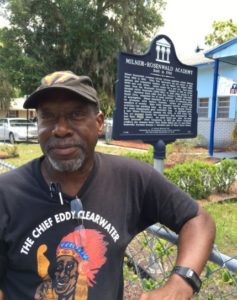Editor’s note: This February marks the 43rd anniversary of Black History Month. redefinED is taking the opportunity to revisit some pieces from our archives appropriate for this annual celebration. The article below originally appeared in redefinED in July 2016.
This is the latest post in our series on the center-left roots of school choice.

The school was all black. The textbooks, hand-me-down. The teachers paid less. Yes, the Milner-Rosenwald Academy in Mount Dora, Fla., was separate and unequal, said Ozell Ward, who attended 60 years ago.
And yet, in his view, it was better.
Teachers were invested, he said. Parents were engaged.
The community made it their “anchor.”
“Education-wise, I think I had one of the best foundations, period, despite the so-called handicaps,” said Ward, 69, a retired human resources consultant.
It may seem odd to highlight a segregated, Deep South school for a series about the roots of school choice. But the K-8 Milner-Rosenwald Academy was built during an all-but-forgotten campaign, nearly a century ago, to expand educational opportunity throughout the South. Like today’s school choice movement, it was propelled by a desire to give more and better to the kids who need it the most. The school and literally thousands like it reflected many of the core characteristics that have long defined the struggle for educational freedom, particularly in the African American experience.
It offered options (in this case, of having one formal, quality school or none at all). Private sector support. Close ties to churches and faith leaders.
And local control.
“The school was the center of the community,” said Vivian Owens, a former chemist and retired public school science teacher who also attended Milner-Rosenwald. “And the community supported it in every way.”
Irony abounds. Mount Dora, population 12,000, is a charmer of a town in the middle of Lake County, an easy-on-the-eyes stretch of Central Florida known for citrus-covered hills, stunning lake vistas – and notorious, racist violence. For nearly 30 years, it was ruled by Sheriff Willis McCall, the overseer for the county’s white bankers and citrus barons. McCall was the dark force at the center of the Groveland Four case, which generated international headlines in the 1940s and ‘50s and pitted him against Thurgood Marshall, the larger-than-life NAACP lawyer who, at the same time, was leading the charge to desegregate public schools. Thanks to the 2012 Pulitzer Prize winning book, “Devil in the Grove,” a movie is being made about the case, potentially giving millions of Americans a glimpse of the home-grown terrorism that, not long ago, was as much a part of the Florida landscape as sugar-sand beaches.
This was Florida at its worst. Yet for many African Americans here, it was also a golden age for education.
Despite racism, segregation, and Sheriff McCall – or maybe because of it – the tight-knit black community in Mount Dora was able to create and sustain a school that carried out its vision of progress for 44 years. The Milner-Rosenwald Academy helped dreams come true against a backdrop of nightmares, lifting generations of African Americans into the middle class and a better life.
By the early 1930s, there were 5,000 “Rosenwald schools” from Maryland to Texas, educating as many as a third of the South’s black students, including poet Maya Angelou and Georgia Congressman John Lewis. They were seeded with money from Julius Rosenwald, president of Sears Roebuck and, perhaps, “the greatest American philanthropist you’ve never heard of.”
Working hand in hand with Booker T. Washington, Rosenwald wanted to take African-American education to another level. Sometimes, that meant community-led alternatives to the deplorable “schools” that state and local governments left to African Americans, or to schools that black communities scratched out on their own. Sometimes, it meant a school, period.
Technically, Rosenwald schools were public. Rosenwald chipped in if the black community raised matching funds and, in many cases, acquired the land. The community also had to convince the white school board to agree to maintain the school.

According to Owens, the first school for African Americans in Mount Dora was established in 1886, in the same school white students used. The black students could only use it when the white students weren’t there. Black students eventually got a school of their own, but when it burned down in 1922, local governments made no effort to build a new one, Owens wrote in “The Mount Dorans,” a book about the community’s history.
Ward, whose family’s roots in Lake County go back 130 years, said to the black community, education was as necessary as air to breathe. It had to find a replacement school ASAP.
Enter Rosenwald.
For matching funds, the black community turned to Mount Dora resident Duncan Milner, a white Presbyterian minister described in a history of the school as a “militant idealist” and “passionate foe of racial bigotry and oppression.” He made a big donation. The community did the rest.
The school opened in 1926 and eventually enrolled 240 students a year. It thrived until 1970.
Ward said discipline problems didn’t fester. Teachers and parents were neighbors; they communicated constantly and trusted each other. Nobody graduated without mastering the basics because teachers wouldn’t let them. Those who got accepted into college but couldn’t afford tuition found money funneled their way.
“Those little things were provided, somehow,” Ward said. “Those were the nurturing things everyone talks about. The community would step up. It would find a way.”
Owens said the black community lost more than it realized when Lake County schools integrated and Milner-Rosenwald became Mount Dora Middle School. Many, perhaps, had unrealistic expectations for the new era in education, which offered the promise of better race relations but also scrapped community control in exchange for assigned schools.
“Black people had the perception that when they got to the white schools, things would be so much better,” she said. “But they weren’t.”
Many black students were placed in “slower classes,” she said. Their new, white teachers didn’t know them like their former teachers did, she said, and didn’t expect as much of them.
Owens said her science teacher at Milner-Rosenwald, Mr. Richardson, once chewed her out for getting a 96 on a test. She was so upset, she called him a “bald headed grapefruit.” But Mr. Richardson didn’t let it go.
He told his student: “You have to aim higher. Don’t be content to do better than folks here. You have to compete in the world.”
Lesson learned, Owens said.
And maybe, lesson lost.


